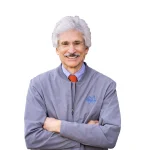About 25 percent of all orthodontic treatment performed today is on adult patients. Chances are that you too can benefit from orthodontics.
Why Should You Have Orthodontic Treatment
Orthodontics can help you enjoy a straighter smile, with more balanced teeth, a greater self-confidence, easier brushing and flossing, and even a greater ease in chewing and swallowing, and a reduced chance of developing periodontal (gum) disease later on.
What Happens at My First Appointment?
First, your teeth, jaw, bite, and profile are evaluated by Dr. Bertolini. A panoramic x-ray, showing your head, face, and jaw is taken to aid the doctor to take specific measurements and plan your treatment. Impressions of your teeth are taken to record the way your teeth and jaw fit together. Dr. Bertolini then has photographs taken of your face, teeth, and profile. Often the difference between before and after photos is astounding! From these diagnostic records, Dr. Bertolini determines the type of malocclusion (improper bite) you have, as well as any other orthodontic problems.
How Are Teeth Moved?
Dr. Bertolini moves teeth into a position using one or more appliances (braces and retainers). Braces work by gently applying pressure to your teeth. This causes the bone to be absorbed on one side while new bone grows in and slowly hardens on the other side of your teeth, holding your teeth in the new position.
Treatment Considerations
There are a number of factors taken into consideration when determining the best method of treatment for your individual case and the amount of time necessary to achieve your desired result.

Here is some orthodontic lingo you may hear throughout your treatment:
- Bands are the metal braces usually attached to your back teeth.
- Brackets are often bonded to your teeth, to hold special archwires.
- Spacers are small pieces of wire or plastic worn between your teeth for a week or two prior to getting your braces.
- Archwires are the wires conforming to the dental arch used with braces to slowly move the irregular teeth into proper occlusion.
- Lingual Braces are placed behind the teeth, so the brackets are not seen, for aesthetic purposes.
- Headgear is sometimes prescribed to help the braces move your teeth.
- Elastics are tiny rubber bands used to apply pressure to individual teeth, to help them move faster.
- Retainers are often used to hold your teeth in their correct position after the braces come off. These can be permanent or removable.

